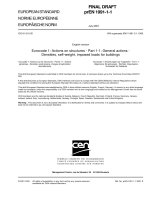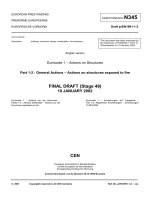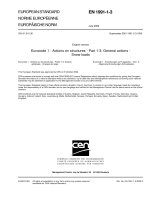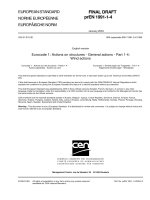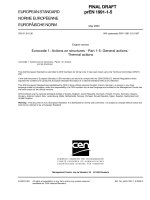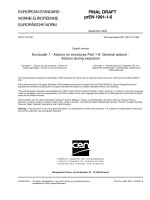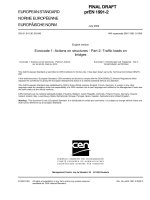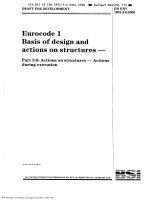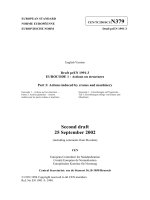Design of aluminium structures Eurocode 8 Part 6 - prEN 1998-6 (01-2003)
Bạn đang xem bản rút gọn của tài liệu. Xem và tải ngay bản đầy đủ của tài liệu tại đây (262.58 KB, 45 trang )
Final PT Draft (Stage 34)
Draft January 2003
Page 1
prEN 1998-6:200X
EUROPEAN STANDARD
NORME EUROPÉENNE
EUROPÄISCHE NORM
prEN 1998-6
Doc CEN/TC250/SC8/N344
English version
Eurocode 8: Design provisions for earthquake resistance of structures
Part 6: Towers, masts and chimneys
DRAFT No 3
Final Project Team Draft (Stage 34)
January 2003
CEN
European Committee for Standardization
Comité Européen de Normalisation
Europäisches Komitee für Normung
Central Secretariat: rue de Stassart 36, B1050 Brussels
CEN 2003 Copyright reserved to all CEN members
Ref.No: prEN 1998-3:200X
Final PT Draft (Stage 34)
Draft January 2003
Page 2
prEN 1998-6:200X
Contents
FOREWORD ................................................................................................................ 5
NATIONAL ANNEX FOR EN 1998-6 ....................................................................... 5
1
GENERAL ............................................................................................................ 6
1.1
SCOPE OF PART 6 OF EUROCODE 8 ................................................................ 6
1.2
REFERENCES ................................................................................................... 6
1.3
ASSUMPTIONS ................................................................................................ 7
1.4
DISTINCTION BETWEEN PRINCIPLES AND APPLICATION RULES .................... 8
1.5
DEFINITIONS ................................................................................................... 8
1.5.1
Special terms used in EN 1998-6............................................................ 8
1.6
SYMBOLS ........................................................................................................ 9
1.6.1
General ................................................................................................... 9
1.6.2
Further symbols used in Part 6 .............................................................. 9
1.7
S.I. UNITS ....................................................................................................... 9
2
PERFORMANCE REQUIREMENTS AND COMPLIANCE CRITERIA . 10
2.1
FUNDAMENTAL REQUIREMENTS .................................................................. 10
2.2
COMPLIANCE CRITERIA ................................................................................ 10
2.2.1
General ................................................................................................. 10
2.2.2
Ultimate limit state ............................................................................... 10
2.2.3
Damage limitation state ....................................................................... 11
3
SEISMIC ACTION ............................................................................................ 12
3.1
3.2
3.3
3.4
3.5
3.6
DEFINITION OF THE SEISMIC INPUT.............................................................. 12
ELASTIC RESPONSE SPECTRUM .................................................................... 12
DESIGN RESPONSE SPECTRUM ..................................................................... 12
TIME-HISTORY REPRESENTATION ................................................................ 12
LONG PERIOD COMPONENTS OF THE MOTION AT A POINT .......................... 12
SPATIAL VARIABILITY OF THE SEISMIC MOTION ......................................... 13
4
DESIGN OF EARTHQUAKE RESISTANT TOWERS, MASTS AND
CHIMNEYS ................................................................................................................ 14
4.1
IMPORTANCE FACTORS ................................................................................ 14
4.2
NUMBER OF DEGREES OF FREEDOM ............................................................ 14
4.3
MASSES......................................................................................................... 14
4.4
STIFFNESS ..................................................................................................... 15
4.5
DAMPING ...................................................................................................... 16
4.6
SOIL-STRUCTURE INTERACTION .................................................................. 16
4.7
METHODS OF ANALYSIS ............................................................................... 16
4.7.1
Applicable methods .............................................................................. 16
4.7.2
Simplified dynamic analysis ................................................................. 17
4.7.3
Modal analysis...................................................................................... 18
4.8
COMBINATIONS OF THE SEISMIC ACTION WITH OTHER ACTIONS ............... 19
4.9
DISPLACEMENTS .......................................................................................... 20
4.10 SAFETY VERIFICATIONS ............................................................................... 20
4.10.1
Ultimate limit state ............................................................................... 20
4.10.2
Resistance capacity of the structural elements..................................... 20
4.10.3
Second order effects ............................................................................. 20
4.11 THERMAL EFFECTS ....................................................................................... 21
Final PT Draft (Stage 34)
Draft January 2003
Page 3
prEN 1998-6:200X
4.12 DUCTILITY CONDITION ................................................................................ 21
4.13 STABILITY..................................................................................................... 21
4.14 SERVICEABILITY LIMIT STATE ..................................................................... 21
4.15 BEHAVIOUR FACTOR .................................................................................... 21
4.15.1
General ................................................................................................. 21
4.15.2
Values of factor kr ................................................................................. 22
5
SPECIFIC RULES FOR REINFORCED CONCRETE CHIMNEYS ......... 23
5.1
BASIC BEHAVIOUR FACTOR ......................................................................... 23
5.2
MATERIALS .................................................................................................. 23
5.3
GENERAL ...................................................................................................... 23
5.3.1
Minimum reinforcement (vertical and horizontal) ............................... 23
5.3.2
Distance between reinforcement bars .................................................. 24
5.3.3
Minimum reinforcement around openings ........................................... 24
5.3.4
Minimum cover to the reinforcement ................................................... 24
5.3.5
Reinforcement splicing ......................................................................... 24
5.3.6
Concrete placement .............................................................................. 24
5.3.7
Construction tolerances........................................................................ 25
5.4
DESIGN LOADS ............................................................................................. 25
5.4.1
Construction loading ............................................................................ 25
5.5
SERVICEABILITY LIMIT STATES ................................................................... 25
5.6
ULTIMATE LIMIT STATE ............................................................................... 26
6
SPECIAL RULES FOR STEEL CHIMNEYS ................................................ 27
6.1
6.2
6.3
6.4
6.5
6.6
7
SPECIAL RULES FOR TOWERS................................................................... 30
7.1
7.2
7.3
7.4
7.5
7.6
7.7
8
BASIC BEHAVIOUR FACTOR ......................................................................... 27
GENERAL ...................................................................................................... 27
MATERIALS .................................................................................................. 27
DESIGN LOADS ............................................................................................. 28
SERVICEABILITY LIMIT STATE ..................................................................... 28
ULTIMATE LIMIT STATE ............................................................................... 29
GENERAL AND BASIC BEHAVIOUR FACTOR ................................................. 30
MATERIALS .................................................................................................. 31
DESIGN LOADS ............................................................................................. 31
STRUCTURAL TYPES ..................................................................................... 31
ELECTRIC TRANSMISSION TOWERS .............................................................. 32
SERVICEABILITY LIMIT STATE ..................................................................... 32
RULES OF PRACTICE ..................................................................................... 32
SPECIAL RULES FOR MASTS ...................................................................... 34
8.1
8.2
8.3
8.4
BASIC BEHAVIOUR FACTOR ......................................................................... 34
MATERIALS .................................................................................................. 34
SERVICEABILITY LIMIT STATE ..................................................................... 34
GUYED MASTS .............................................................................................. 34
ANNEX A (INFORMATIVE) ................................................................................... 36
LINEAR DYNAMIC ANALYSIS ACCOUNTING FOR A ROTATIONAL
SEISMIC SPECTRUM.............................................................................................. 36
ANNEX B (INFORMATIVE) ................................................................................... 39
Final PT Draft (Stage 34)
Draft January 2003
Page 4
prEN 1998-6:200X
ANALYSIS PROCEDURE FOR DAMPING.......................................................... 39
ANNEX C (INFORMATIVE) ................................................................................... 41
SOIL-STRUCTURE INTERACTION ..................................................................... 41
ANNEX D (INFORMATIVE) ................................................................................... 43
NUMBER OF DEGREES OF FREEDOM AND NUMBER OF MODES OF
VIBRATION ............................................................................................................... 43
ANNEX E (INFORMATIVE) ................................................................................... 44
MASONRY CHIMNEYS........................................................................................... 44
Final PT Draft (Stage 34)
Draft January 2003
Page 5
prEN 1998-6:200X
FOREWORD
(1)
For the design of structures in seismic regions the provisions of this Prestandard
are to be applied in addition to the provisions of the other parts of Eurocode 8 and the
other relevant Eurocodes. In particular, the provisions of the present Prestandard
complement those of Eurocode 3, Part 3-1 " Towers and Masts ", and Part 3-2 "
Chimneys", which do not cover the special requirements of seismic design.
NATIONAL ANNEX FOR EN 1998-6
Notes indicate where national choices have to be made. The National Standard
implementing EN 1998-6 shall have a National annex containing all Nationally
Determined Parameters to be used for the design in the country. National choice is
required in the following sections.
Reference section
Item
2.1
Rules for low seismicity region. Value of the soil peak
acceleration for a site being in this category.
4
Importance factors for musts towers and chimneys.
4.11
Temperature of structural elements above which the thermal
effect on the mechanical properties shall be accounted for.
4.14
Values of the reduction factor ν that takes into account the
shorter return period of the seismic action associated with the
damage limitation requirement.
4.7.2.1
Height of the structure below which simplified dynamic
analysis is allowed.
7.7
Behaviour factors for towers made of trussed tubes.
8.3
Drift ratio for masts.
Final PT Draft (Stage 34)
Draft January 2003
1
Page 6
prEN 1998-6:200X
GENERAL
1.1
Scope of Part 6 of Eurocode 8
(1)P EN 1998-6 establishes requirements, criteria, and rules for design of tall slender
structures: towers, including bell-towers, intake towers, radio and tv-towers, masts,
industrial chimneys and lighthouses. Different provisions apply to reinforced concrete
and to steel structures. Requirements are set up for non-structural elements, such as the
lining material of an industrial chimney, antennae and other technological equipment.
(2)P The present provisions do not apply to cooling towers and offshore structures.
For towers supporting tanks, see EN 1998-4.
1.2
Normative References
(1)P The following normative documents contain provisions, which through
references in this text, constitute provisions of this European standard. For dated
references, subsequent amendments to or revisions of any of these publications do not
apply. However, parties to agreements based on this European standard are encouraged
to investigate the possibility of applying the most recent editions of the normative
documents indicated below. For undated references the latest edition of the normative
document referred to applies.
1.2.1
General reference standards
EN 1990:2002
Eurocode - Basis of structural design
EN 1992-1-1:200X Eurocode 2 – Design of concrete structures – Part 1-1: General –
Common rules for building and civil engineering structures
EN 1993-1-1:200X
General rules
Eurocode 3 – Design of steel structures – Part 1-1: General –
EN 1994-1-1:200X Eurocode 4 – Design of composite steel and concrete structures –
Part 1-1: General – Common rules and rules for buildings
EN 1995-1-1:200X Eurocode 5 – Design of timber structures – Part 1-1: General –
Common rules and rules for buildings
EN 1996-1-1:200X Eurocode 6 – Design of masonry structures – Part 1-1: General –
Rules for reinforced and unreinforced masonry
EN 1997-1:200X
Eurocode 7 - Geotechnical design – Part 1: General rules
EN 1999-1-1:200X
rules
Eurocode 9 – Design of aluminium structures – Part 1: General
1.2.2
Reference Codes and Standards
(1)P EN 1998-6:200X incorporates other normative references cited at the
appropriate places in the text. They are listed below:
Final PT Draft (Stage 34)
Draft January 2003
Page 7
prEN 1998-6:200X
ISO 1000
S I Units and recommendations for the use of their multiples and of
certain other units.
ISO 8930
General principles on reliability for structures - List of equivalent terms.
EN 1090-1
Execution of steel structures - General rules and rules for buildings.
EN 10025
Hot rolled products of non-alloy structural steels - Technical delivery
conditions.
prEN 1337-1 Structural bearings - General requirements.
prEN 10080-1 Steel for reinforcing of concrete - Weldable reinforcing steel- Part 1:
General requirements, of March 1999.
prEN 10080-2 Steel for reinforcing of concrete - Weldable reinforcing steel-Part 2:
Technical delivery conditions for class A, of March 1999.
prEN 10080-3 Steel for reinforcing of concrete - Weldable reinforcing steel-Part 6:
Technical delivery conditions for class B, of March 1999.
prEN 10080-4 Steel for reinforcing of concrete - Weldable reinforcing steel-Part 4:
Technical delivery conditions for class C, of March 1999.
prEN 10080-5 Steel for reinforcing of concrete - Weldable reinforcing steel-Part 5:
Technical delivery conditions for welded fabric, of March 1999.
prEN 10080-6 Steel for reinforcing of concrete - Weldable reinforcing steel-Part
6:Technical delivery conditions for lattice girders, of March 1999.
prEN 206:2000
Concrete. – Part 1: Specification, performance, production and
conformity, January 2000.
ISO
Structural steel - Cold formed, welded, hollo sections -Dimensions and
sectional properties.” Draft International Standard, ISI/DIS 4019, edited
by ISO/TC 5/SC1, 1999.
prEN 10138 Prestressing steel. Part 1: General requirements. Part 2: Stress relieved
cold drawn wire. Part 6: Strand. Part 4: Hot rolled and processed bars.
Part 5: Quenced and tempered wire, November 1991.
1.3
(1)P
Assumptions
The following assumptions apply:
− The design of structures is accomplished by qualified and experienced personnel.
− Adequate supervision and quality systems are provided in design offices, factories,
plants and on site.
− Personnel having the appropriate skill and experience carry out the construction.
− The construction materials and products are used as specified in the Eurocodes or in
the relevant material or product specifications.
Final PT Draft (Stage 34)
Draft January 2003
Page 8
prEN 1998-6:200X
− The structure will be adequately maintained.
− The structure will be used in accordance with the design brief.
− No change of the structure will be made during the construction phase or during the
subsequent life of the structure, unless proper justification and verification is
provided. Due to the specific nature of the seismic response, this applies even in the
case of changes that lead to an increase of the structural resistance.
(2)
In this code numerical values identified by [ ] are given as indications. The
National Authorities may specify different values.
1.4
(1)
1.5
Distinction between principles and application rules
The rules of clause 1.4 of EN 1990:2002 apply.
Definitions
(1)
Unless otherwise stated in the following, the terminology used in International
Standard ISO 8930 applies.
1.5.1
Special terms used in EN 1998-6
Stack: Stacks, flues, chimneys are construction works or building components that
conduct waste gases, other flue gases, supply or exhaust air.
Supporting shaft or shell: The supporting shaft is the structural component, which
supports the waste gas flues.
Waste gas flue: The flue that conducts waste gases is a component that carries waste
gases from fireplaces through the stack outlet into atmosphere.
Internal flue: The internal flue is a waste gas conducting flue that is installed inside of
the supporting shaft which protects all other stack components against thermal and
chemical strains and aggressions.
Transmission tower: a tower used to support electric transmission cables, either at low
or high voltage.
Tangent towers: Electric transmission towers used where the cable line is straight or
has an angle not exceeding 3 degrees in plane. They support vertical loads, a transverse
load from the angular pull of the wires, a longitudinal load due to unequal spans, and
forces resulting from the wire-stringing operation, or a broken wire.
Angle towers: Towers used where the line changes direction by more than 3 degrees in
plane. They support the same kinds of load as the tangent tower.
Dead-end towers (also called anchor towers): Towers able to support dead-end pulls
from all the wires on one side, in addition to the vertical and transverse loads.
Other special, earthquake-related terms of structural significance used in Part 6 are
defined in 1.4.2 of Part 1-1.
Final PT Draft (Stage 34)
Draft January 2003
1.6
1.6.1
Page 9
prEN 1998-6:200X
Symbols
General
(1)
For the material-dependent symbols as well as for symbols not specifically
related to earthquakes the provisions of the relevant Eurocodes apply.
(2)
Further symbols, used in connection with seismic actions, are defined in the text
where they occur, for ease of use. However, in addition, the most frequently occurring
symbols used in EN 1998-6 are listed and defined in 1.6.2.
1.6.2
Further symbols used in Part 6
Eeq
equivalent modulus of elasticity;
Mi
effective modal mass for the i-th mode of vibration.
Rθ
(given a one degree of fredom oscillator), the ratio between the maximum
moment on the oscillator spring and the rotational moment of inertia about the
axis of rotation. The diagram of Rθ versus the natural period is the rotation
response spectrum;
Rθx , Rθy , Rθz the rotation response spectra around the axis x, y and z, in rad/sec2
γ
specific weight of the cable per unit volume;
σ
tensile stress in the cable;
j
1.7
equivalent modal damping ratio of the j-th mode,
S.I. Units
(1)P S.I. Units shall be used in accordance with ISO 1000. Forces are expressed in
Newton’s or kiloNewtons, masses in kg or tons, and geometric dimensions in meters or
mm.
Final PT Draft (Stage 34)
Draft January 2003
2
Page 10
prEN 1998-6:200X
PERFORMANCE REQUIREMENTS AND COMPLIANCE CRITERIA
2.1
Fundamental requirements
(1)P The design philosophy of EN 1998-6, is based on the general requirement that,
under earthquake conditions, 1) danger to people, nearby buildings and adjacent
facilities shall be prevented, and 2), the continuity of the function of plants, industries,
and communication systems has to be maintained. The first condition identifies for the
present structures with the non-collapse requirement defined in 2.1 of EN 1998-11:200X and the second condition with the damage limitation requirement defined in 2.1
of EN 1998-1-1:200X.
(2)P The damage limitation requirement refers to a seismic action having a
probability of occurrence higher than that of the design seismic action. The structure
shall be designed and constructed to withstand this action without damage and
limitation of use, the cost of damage being measured with regards to the cost of
involved equipment, and cost of limitation of use with regards to the cost of the
interruption of activity of the plant. To this requirement importance classes are defined
in 4.2.5.
(3)
In regions of low seismicity, the rule 2.2.1 and the application of earthquake
forces given in 4.6.2 adequately satisfy the fundamental requirements. It is
recommended to consider as low seismicity region those in which the design ground
acceleration ag, on type A soil, is not higher than [0,08 g].
2.2
2.2.1
Compliance criteria
General
(1)P With the only exceptions explicitly mentioned in the present document, concrete
structures shall conform to EN 1992, steel structures to EN 1993, and composite
structures to EN 1994. Wind snow, and ice loads are defined in EN 1991.
(2)P
For foundation design, see EN 1998-5:200X.
2.2.2
Ultimate limit state
(1)
Most of the present structures are classified as non-dissipative, thus no account
is taken of hysteretic energy dissipation and a behaviour factor not higher than 1,5 is
selected. For dissipative structures a behaviour factor higher than 1,5 is adopted. It
accounts for hysteretic energy dissipation occurring in specifically designed zones,
called dissipative zones or critical regions.
(2)P The structure shall be designed so that after the occurrence of the design seismic
event, it shall retain its structural integrity, with appropriate reliability, with respect to
both vertical and horizontal loads. For each structural element, the amount of inelastic
deformation shall be confined within the limits of the ductile behaviour, without
substantial deterioration of the ultimate resistance of the element.
Final PT Draft (Stage 34)
Draft January 2003
Page 11
prEN 1998-6:200X
(3)
Unless special precautions are taken, provisions of the Code do not specifically
provide protection against damage to equipment and non-structural elements during the
design seismic event.
2.2.3
Damage limitation state
(1)
In the absence of a well precise requirement of the Owner, satisfying the
deformation limits defined in 6.2.5 will ensure that damage would be prevented to the
structure itself, to non-structural elements and to the installed equipment.
2.2.3.1 Foundations
(1)P The stiffness of the foundations shall be adequate for transmitting to the ground,
as uniformly as possible, the actions received from the superstructure assuming a
behaviour factor not greater than 1,5.
Final PT Draft (Stage 34)
Draft January 2003
3
3.1
Page 12
prEN 1998-6:200X
SEISMIC ACTION
Definition of the seismic input
(1)
The free-field seismic excitation is specified through the definition of the
translation motion at a point. For particular structures, the spatial variability of the
translation motion at a point is important. The rotation motion at the point defines it.
(2)
The translation motion is defined as in EN 1998-1-1:200X and the rotation
motion is defined in Annex A.
3.2
Elastic response spectrum
(1)P The elastic response spectrum for acceleration is defined in clause 3.2.2 of EN
1998-1:200X. The influence of local ground conditions on the seismic action shall
generally be accounted for by considering the five ground types A, B, C, D and E
described in clause 3.1.1 of EN 1998-1:200X, according to the stratigraphic profiles.
The transmission level is the elevation of the lower-most level of the foundation, or the
top of the piles, if present.
3.3
Design response spectrum
(1)
The design response spectrum is the q-reduced response spectrum, defined in
3.2.2.5 of EN 1998-1-1:200X. The behaviour factor q incorporates the elastic
dissipation in the structure and that due the soil-to structure interaction and to the
inelastic hysteretic behaviour of the structure.
3.4
Time-history representation
(1)
If time-domain analyses are performed, both artificial accelerograms and
records of historic strong motion can be used. Time-histories are generally used for
non-linear step by step analyses. The relevant peak value and frequency content shall be
consistent with the elastic response spectrum, (not with the q- reduced design response
spectrum).
(2)
In case artificial accelerograms are used, independent time history can be
generated for translation and rotation acceleration.
(3)
The strong motion duration should be selected in a way consistent with clause
3.2.3.1.2 of EN 1998-1:200X.
3.5
Long period components of the motion at a point
(1)
Towers, masts, and chimneys are sensitive to the long period components of the
seismic excitation. Soft soils or peculiar topographic conditions might provide
abnormal amplifications to these components.
(2)
A suitable geological and geotechnical survey should be developed, to identify
the soil properties. It should be extended at least until the depth at which the static
effects of the structure, due to dead load, are significant
Final PT Draft (Stage 34)
Draft January 2003
Page 13
prEN 1998-6:200X
(3)
Lacking the geotechnical survey, the design spectrum corresponding to a soil
profile more unfavourable for the structure shall be assumed, (see clause 3.2.2.2 of EN
1998-1:200X), with a soil factor S = 1,5
(4)
Where site-specific studies of the ground motion have been carried out, with
particular reference to the long period motions, the limitation of clause 3.2.2.5 of EN
1998-1:200X, Sd ≥ 0,2 α, may be relaxed to Sd ≥ 0,1 α.
3.6
Spatial variability of the seismic motion
(1)
Structures taller than 80 meters, in regions of high seismic activity, α > [0,25],
should be analysed with proper consideration to a spatial model of the seismic
excitation.
(2)
In general, tall structures may be sensitive to a spatially varying vertical
excitation: a vertical ground motion propagating in any horizontal direction is expected
to cause rocking of the structure, concurrent with the rocking caused by the horizontal
excitation along that direction.
(3)
A possible model to describe the rotation motion is given in Annex A.
Final PT Draft (Stage 34)
Draft January 2003
4
4.1
Page 14
prEN 1998-6:200X
DESIGN OF EARTHQUAKE RESISTANT TOWERS, MASTS AND
CHIMNEYS
Importance factors
(1)P The following factors are applicable, in the absence of a more detailed risk
analysis:
γI = [1,4] for structures whose operation is of strategic importance, in particular if vital
component of a water supply system, an electric power plant or a
communication facility.
γI = [1,2] for structures the height of which is greater than the distance from the
surrounding buildings, for structures built in an area likely to be crowded, or for
structures whose collapse may cause the shutdown of industries.
γI = [1,1] for all structures taller than 80 m, not pertaining to the above category.
γI = [1,0] for the remaining cases.
4.2
(1)
Number of degrees of freedom
The mathematical model should consider:
− Rocking and translation stiffness of foundations;
− An adequate number of masses and degrees of freedom to determine the response of
any significant structural element, equipment, and appendages;
− The mass and stiffness of cables and guys;
− The relative displacement among supports of equipment or machinery (for a
chimney, the interaction between internal and external tubes);
− Significant effects such as piping interactions, externally applied structural
restraints, hydrodynamics loads (both mass and stiffness effects);
(2)
The torsion stiffness of the foundation shall be included if significant.
(3)
For electric transmission towers, unless a complete dynamic model is made for a
representative portion of the entire line, a group of at least three towers has to be
modelled, so that an acceptable evaluation of the cable mass and stiffness can be
accounted for the central tower.
4.3
Masses
(1)P The model shall include a discretization of masses so that a suitable
representation of the inertia effects is ensured. As appropriate, translation and/or
rotational mass shall be considered.
(2)P The masses shall include all permanent constructions, fittings, insulation, dust
loads, clinging ash, present and future coatings, liners and the effect of fluids or
moisture on density of liners, if relevant, and equipment. Permanent masses of
structures and quasi-permanent equipment masses shall be considered.
Final PT Draft (Stage 34)
Draft January 2003
Page 15
prEN 1998-6:200X
Applicable ψ2i values are:
(3)
− imposed loads on platforms ψ2i = 0,2;
− maintenance loads on platforms ψ2i = 0,2;
− temporary equipment on transmission towers and masts ψ2i = 0,8;
− For towers and masts in cold regions a suitable proportion of ice load shall be
included.
(4)P If cables are present, a correct representation of the relevant masses shall be
included in the model.
(5)
Idealising a cable as a single spring does not allow for its inertia and consequent
dynamic response. When the mass of the cable is significant in relation to that of the
tower, the cable should be represented as chain of elements connecting lumped masses.
(6)
The total effective mass of the immersed part of intake towers shall be assumed
equal to the sum of:
− the actual mass of the tower shaft (without allowance for buoyancy);
− the mass of the water possibly enclosed within the tower (hollow towers);
− the added mass of externally entrained water.
(7)
In absence of rigorous analysis, the added mass of entrained water may be
estimated according to Annex F of EN 1998-2:200X.
4.4
Stiffness
(1)
In concrete structures, if the analysis is made on the basis of a suitable q factor
greater than 1, and the corresponding design response spectrum, the section properties
according to 4.3.1 of EN 1998-1-1:200X. If q = 1, and the analysis is based on the
elastic response spectrum or a corresponding time-history of the ground motion, the
element stiffness should take into account the cracked cross-section properties, in
agreement with the expected level of stress.
2
Due regards shall be given to the temperature effect on the stiffness and strength
of the steel in steel chimneys structures.
(3)
In case cables are integral part of a structure, a careful modelling of their
stiffness should be done.
(4)
If the sag of the cable is significant, the spring value should account for it. An
iterative solution may be generally required. It can be based on the use of the following
equivalent modulus of elasticity:
Ec
Eeq =
1+
where:
(γ l ) 2
12σ 3
(4.1)
Ec
Final PT Draft (Stage 34)
Draft January 2003
Eeq
equivalent modulus of elasticity;
γ
specific weight of the cable, weight per unit volume;
σ
tensile stress in the cable;
Page 16
prEN 1998-6:200X
cable length;
Ec
modulus of elasticity of cable material.
(5)
For wrapped up ropes, Ec is generally lower than the single cord modulus of
elasticity E. An applicable reduction is
Ec
= cos 3 β
E
(4.2)
where β is the wrapping angle of the single cords.
(6)
In cases where the sag of the cable is meaningful, the likelihood of impulsive
loading between tower and the cable ends should be analysed.
(7)
If the preload of the cable is such that the sag is meaningless, or if the tower is
short, (less than 40 meters), then the presence of the cable can be represented in the
dynamic model by a linear spring.
4.5
Damping
(1)
If the analysis is performed without resorting to the reduced design spectrum, it
is allowed to consider damping values different from 5%. In this case, the damping
ratio of each mode of vibration may be defined according to Annex B and the
corresponding elastic spectral ordinates as prescribed in 3.2.2.2(3) of EN 1998-11:200X.
4.6
Soil-structure interaction
(1)
The design earthquake motion is defined at the soil surface, in free-field
conditions, i.e. where it is not affected by the inertial forces due to the presence of
structures. When the structure is founded on soil deposits or soft media, the resulting
motion at the base of the structure will differ from that at the same elevation in the
free-field, due to the soil deformability. Annex C provides suitable rules to account for
soil compliance during earthquakes.
(2)
For tall structures, (the height being over two times the maximum base
dimension), the rocking compliance of the soil is important and may significantly
increase the second order effects.
4.7
4.7.1
Methods of analysis
Applicable methods
(1)
The standard methods of analysis is the linear analysis using the q-reduced
design spectrum either as a simplified dynamic analysis or a multimodal analysis.
Final PT Draft (Stage 34)
Draft January 2003
Page 17
prEN 1998-6:200X
(2)
Non-linear methods of analysis may be applied provided that they are properly
substantiated with respect to the seismic input, the constitutive model used, the method
of interpreting the results of the analysis, and the requirements to be met (see clause
4.3.3.1 of EN 1998-1-1:200X).
4.7.2
Simplified dynamic analysis
4.7.2.1 General
(1)
This type of analysis are generally applied to structures that can be analysed by
two planar models and whose response is not significantly affected by contributions of
higher modes of vibration.
(2)P For regular structures, the method set forth in the literature based on the "rigid
diaphragm" assumption, can be applied. For steel masts, an horizontal bracing system,
capable of providing the required rigid diaphragm action, is to be present. Lacking this,
a three dimensional dynamic analysis is necessary.
(3)P For steel chimneys, horizontal stiffening rings shall be present in the design, for
the "rigid diaphragm" assumption being applicable. Otherwise, a suitable dynamic
analysis, capable of identifying the hoop stresses, is required.
(4)
Piping and equipment supported at different points should be analysed taking
into account the relative motion between supports. This motion may be larger that that
conceived by the simplified analysis.
(5)
For reinforced concrete towers and chimneys, hoop reinforcement should take
into account the ovalling of the horizontal cross section due to lateral forces. A dynamic
analysis capable of identifying the hoop stresses, is suitable.
(6)
Simplified dynamic analysis is allowed only if the importance factor is γI < 1,
and the height is H < [80] m.
4.7.2.2 Seismic forces
(1)
The effects induced by the seismic action are determined by subdividing the
structure into n distinct concentrated masses, including the masses of the foundations,
to which the horizontal forces Fi, i = 1, 2...n, are applied, given by the expression:
Fi =
hi wi
n
∑ h jw j
Ft
(4.3)
1
where
n
Ft = S d (T )∑ w j
(4.4)
1
wi
weight of the i-th mass including permanent load and variable loads multiplied
by the pertinent combination factor specified in 4.3;
Final PT Draft (Stage 34)
Draft January 2003
hi
Page 18
prEN 1998-6:200X
is the elevation of the i-th mass from the level of application of the seismic
excitation;
Sd (T) is the ordinate of the design spectrum as defined in EN 1998-1:200X, for the
fundamental period of vibration T. In case the period T is not evaluated through
a valuable structural model, the spectral value Sd (Tc) shall be accounted for.
(2)
The above method may provide a substantial overvaluation of the seismic action
in the case of tapered towers where around the base the mass distribution sharply
decreases with elevation.
4.7.3
Modal analysis
4.7.3.1 General
(1)
This method of analysis can be applied to any structure, with an input motion
defined by a response spectrum or by the corresponding time history.
4.7.3.2 Number of modes
(1)
For a continuously distributed mass structure, cantilevering from the soil, the
minimum number of modes, necessary to assure participation of all significant modes,
is higher than the number suitable for a "shear type" building, with lumped masses.
(2)
The minimum number of modes which is necessary to evaluate internal actions
at the top of the structure is generally higher than that which is sufficient for evaluating
the overturning moment or the total shear at the base of the structure.
(3)
A practical rule to establish the sufficient number of modes is the following. For
each mode i, and for each direction of the excitation, the "equivalent modal mass" Mi is
evaluated. Then, for each direction, the sum of Mi is performed and is compared to the
total mass of the structure M. If
N
∑ M i ≥ 0,9 M
(4.5)
i
then the considered number of modes is adequate. An exception to the above rule may
occur in case when a light equipment or a light structural appendix is concerned.
Appendix D provides hints for the practical application of expression (4.5)
4.7.3.3 Combination of modes
(1)P For each quantity, (force, displacement, stress), the probable maximum value S
of the earthquake effect in general shall be obtained as the square root of the sum of the
squares of the contributions of individual modes, (SRSS combination):
S = ± ( s12 + s22 + s32 + ...)
(4.6)
where:
s1 , s2 , s3
are the contributions to the selected quantity of modes 1, 2, 3... This
action effect assumes both the positive and the negative sign.
Final PT Draft (Stage 34)
Draft January 2003
Page 19
prEN 1998-6:200X
(2)P For any one direction of the seismic excitation, when two significant modes i
and j show closely spaced periods, with the ratio Tj/Ti exceeding 0,9 with Tj < Ti, the
above rules becomes unconservative and more accurate rules must be applied.
4.7.3.4 Combination of different ground motion components
(1)P Effects of different components shall be combined according to clause 4.3.3.5.1
and 4.3.3.5.2 of EN 1998-1-1:200X. The effects of the translation and the rotation
components of the ground excitation can be combined each to the other assuming as
global effect the square root of the sum of the squares of the single effects, (SRSS
combination).
4.7.3.5 Combination of internal actions
(1)P When combining different internal actions, for instance bending moment and
axial forces, each internal action is to be computed according to the above rule. All
physically possible combinations shall be considered.
4.8
Combinations of the seismic action with other actions
(1)P The design value Ed of the effects of actions in the seismic design situation shall
be determined by combining the values of the relevant actions as follows:
∑ Gkj"+"γ I AE
d
"+" Pk "+" ∑ψ 2i Qki
(4.7)
where
"+"
implies "to be combined with";
∑
implies "the combined effect of",
Gkj
characteristic value of permanent action j;
γI
importance factor (see 2.3);
AEd
design value of the seismic action for the reference return period;
Pk
characteristic value of prestressing action;
ψ2i
combination coefficient for quasi permanent value of variable action i;
Qki
characteristic value of variable action i.
(2)P The effects of the seismic action shall be evaluated by taking into account the
presence of all gravity loads appearing in the following combination of actions:
∑ Gkj"+" ∑ψ 2i ⋅Qki
(4.8)
where
ψEi
combination coefficient for variable action i.
(3)
The combination coefficients ψEi take into account the likelihood of the loads
ψ2i Qki being not present over the entire structure during the occurrence of the
Final PT Draft (Stage 34)
Draft January 2003
Page 20
prEN 1998-6:200X
earthquake. These coefficients may also account for a reduced participation of masses
in the motion of the structure due to the nonrigid connection between them.
(4)
Values of coefficient ψ2i are given in 4.3, and values of ψEi are given in 4.2.4 of
EN 1998-1-1:200X. Laking a precise information, for the present structures ψEi = ψ2i
should be assumed.
4.9
Displacements
(1)P The displacements induced by the design seismic action shall be calculated on
the basis of the elastic deformation of the structural system by means of the following
simplified expression:
d s = qd d eγ i
(4.9)
where:
ds
displacement of a point of the structural system induced by the design seismic
action;
qd
displacement behaviour factor, assumed equal to q;
de
displacement of the same point of the structural system, as determined by a
linear analysis based on the design response spectrum.
4.10 Safety verifications
4.10.1 Ultimate limit state
(1)P The safety against collapse (ultimate limit state) under the seismic design
situation is considered to be ensured if the following conditions regarding resistance,
ductility and stability are met.
4.10.2 Resistance capacity of the structural elements
(1)
The following relation must be satisfied for all structural element:
Rd > Ed (γi E, G, P, .....................)
(4.10)
where
Rd
design resistance capacity of the element, calculated according to the
mechanical models and the rules specific to the material, (characteristic value of
property fk, and partial safety factor γm).
Ed
design value of the effect in the combination of actions including, if necessary,
P-∆ effects and thermal effects.
4.10.3 Second order effects
(1)P Second order, P-∆, effects shall be evaluated considering the displacements
computed as indicated in 4.7, unless the condition (2) is respected.
Final PT Draft (Stage 34)
Draft January 2003
Page 21
prEN 1998-6:200X
(2)
Second order, P-∆, effects need not be considered when the following condition
is fulfilled.
δM / Mo < 0,10
(4.10)
where
δM
overturning moment due to P-∆ effect
Mo
first-order overturning moment
4.11 Thermal effects
(1)P If the operating temperature of a structural elements is above [100º C], then the
thermal effects on the mechanical properties of the structural element such as elastic
modulus, yield stress and thermal expansion coefficient shall be taken into account. The
relevant Eurocodes shall be applied to estimate such effects.
4.12 Ductility condition
(1)P It shall be verified that the structural elements and the structure as a whole
possess adequate ductility to its expected exploitation, which depends on the selected
system and the adopted behaviour factor.
4.13 Stability
(1)
The stability of the structure shall be verified under the set of forces induced by
the combination rules including piping interaction and hydrodynamic loads, if present.
(2)
Special criteria of stability verification are reported for steel chimneys and steel
towers and masts in EN 1993-3:200X.
4.14 Serviceability limit state
(1)
Deflections for the serviceability limit state shall be calculated by reducing of
the factor ν, defined in (2), the displacements given in the expression (4.9).
(2)
The reduction factor ν takes into account the shorter return period of the seismic
action associated with the damage limitation requirement. Suggested values are: =
[0,4] for structures to which γI > 1 is assigned, and = [0,5] for other structures.
(3)
If certain use of the structure is significantly affected by deflections, (for
example in telecomunication towers), the deflection should be limited to appropriate
values. Peak transient deflections need to be calculated if they lead to permanent
damage.
4.15 Behaviour factor
4.15.1 General
(1)P
The behaviour factor q is given by the product:
q = qo kr ≥ 1,5
(4.11)
Final PT Draft (Stage 34)
Draft January 2003
Page 22
prEN 1998-6:200X
where:
qo
basic behaviour factor, reflecting the ductility of the lateral load resisting
system, with values defined in 5, 6 and 7 for each different type of structure.
kr
modification factor reflecting departure from a regular distribution of mass,
stiffness or strength, with values defined in 4.15.2.
4.15.2 Values of factor kr
(1)P The value of kr shall be taken as follows, depending of the existence of the
following irregularities on the structure.
a) Horizontal mass eccentricity at a section exceeding 5% of the relevant structure
dimension
kr = 0,8
b) Opening in shaft causing a 30% or larger reduction of the moment of inertia of the
cross section
kr = 0,8
c) Concentrated mass within the top third elevation contributing 50% or more to the
base overturning moment,
kr = 0,7
(2)P When more than one irregularity are present, kr shall be assumed equal to the
product of the two lowest values of kr.
Final PT Draft (Stage 34)
Draft January 2003
5
Page 23
prEN 1998-6:200X
SPECIFIC RULES FOR REINFORCED CONCRETE CHIMNEYS
5.1
Basic Behaviour factor
(1)P Critical regions shall be considered the concrete wall up to a distance d (where d
denotes the outer diameter of the wall) above the bottom cross-section, and above
sections where an abrupt change of thickness is made. Critical regions shall also be
considered the concrete wall where more than one opening exist, and up to a distance d
above and below those openings.
(2)P When a local curvature ductility of the critical sections of at least µ1/r = 9 is
secured, if necessary by providing confining reinforcement,
qo = 3
In all other cases
qo = 1,5
(3)
The design of chimneys is generally governed by wind considerations, with the
exception of locations with medium to high seismicity, chimneys with large elevated
masses, and chimneys with unusual geometries.
5.2
(1)
Materials
All materials and material tests should conform to Eurocode 2.
(2)
The same brand and type of cement should be used throughout the construction
of the chimney wall. The maximum size of coarse aggregate should not be larger than
1/8 of the narrower dimension between forms nor larger than 1/2 the minimum clear
distance between parallel reinforcing bars.
(3)
The specified concrete should be of a class not lower than C20/25 as defined in
Eurocode 2.
5.3
5.3.1
General
Minimum reinforcement (vertical and horizontal)
(1)P For a chimney with an outside diameter of 4 m or more, the minimum ratio of
the vertical reinforcement to the gross-sectional area shall be not less than 0,003. The
reinforcement shall be distributed in layers towards the inner and the outer face, with
not less than half the reinforcement in the layers towards the outer face.
(2)P Close to the chimney top, where stresses due to permanent load are rather small,
a minimum vertical reinforcement equivalent to that for the horizontal direction must be
provided.
(3)P A chimney with an outside diameter of 4 m or more must be provided with
layers of horizontal reinforcement in the proximity of both surfaces and the ratio to the
gross-sectional area shall not be less than 0,001.
Final PT Draft (Stage 34)
Draft January 2003
Page 24
prEN 1998-6:200X
(4)P In chimneys with an outside diameter of less than 4 m, the inner layer of
reinforcement may be omitted, but in that case the ratio of outer layer reinforcement to
gross-sectional area shall not be less than 0,002.
(5)
Circumferential bars should be placed around the exterior of, and secured to the
vertical bars. All reinforcing bars should be tied at intervals of not more than 60 cm.
(6)
Particular attention should be paid to placing and securing the circumferential
reinforcing so that it cannot bulge or be displaced during the pouring and working of
the concrete, so as to result in less than the required concrete cover of the
circumferential reinforcement. Circumferential bars should be closed preferably by
welding. No closure by splicing should be permitted.
5.3.2
Distance between reinforcement bars
(1)
The distance between vertical bars should be not more than 250 mm and the
distance between horizontal bars should not exceed 200 mm.
5.3.3
Minimum reinforcement around openings
(1)
In addition to the reinforcement determined by the stability and temperature,
extra reinforcement should be provided at the sides, bottom, top and corners of
openings as hereinafter specified. This extra reinforcement should be placed near the
outside surface of the chimney shell as close to the opening as proper spacing of bars
will permit. Unless otherwise specified, all extra reinforcement should extend past the
opening a sufficient distance to develop the bars in bond.
(2)
The minimum vertical reinforcement ratio should be 0,0075, in a distance of
half the width of the opening. Both sides of the opening should be reinforced.
5.3.4
Minimum cover to the reinforcement
(1)
The concrete cover to the circumferential reinforcement should be 30 mm
minimum with a tolerance of + 20 mm and - 10 mm.
5.3.5
Reinforcement splicing
(1)
Not more than 50 % of the bars should be spliced along any plane unless
specifically permitted on drawings or approved by the responsible engineering.
5.3.6
Concrete placement
(1)
In the concrete shell no vertical construction joint should be used. Horizontal
construction joint for jump form construction should be maintained at approximately
uniform spacing throughout the height of the chimney.
(2)
Concrete should be deposited in approximately level layers no greater than 40
cm deep. Particular care should be exercised when placing concrete in thin wall
sections where two layers of reinforcing are present.
Final PT Draft (Stage 34)
Draft January 2003
5.3.7
Page 25
prEN 1998-6:200X
Construction tolerances
(1)
The vertical alignment of centerpoint should not vary along the vertical axis by
more than 1/1000 of the height of the shell at the time of measurement, or 2 cm,
whichever is greater.
(2)
The measured outside shell diameter at any section should not vary from the
specified diameter by more than 1/100 of the specified or theoretical diameter.
(3)
The measured wall thickness should not vary from the specified or theoretical
wall thickness by more than -1 +2 cm. A single wall thickness is defined as the average
of at least four measurements taken over a 60-degree arc.
(4)
Tolerances on the size and location of opening and embedments should be
established depending on the nature of their use. Lacking further requirements,
tolerances for opening and embedment sizes and locations are 1/100 of the shell outside
diameter.
5.4
5.4.1
Design loads
Construction loading
(1)
In the design of a chimney for horizontal earthquake forces, only one horizontal
direction need be considered. Unlike building structures, chimneys are generally
axisymmetric, and the orthogonal effects from two horizontal earthquakes acting
simultaneously in the two principal directions are negligible.
(2)
The effect of the vertical component of the earthquake on the chimney is
generally of no design significance, and can be disregarded.
(3)
In cases the lining (brick, steel, or other materials) is laterally supported by the
chimney shell at discrete points close one to the other so that a meaningful relative
movement is not expected during a seismic shaking, the lining can be taken into
account by incorporating its mass into that of the shell.
(4)
For cases in which the chimney lining is supported at the top of the chimney
shell or at intermediate points distant one to the other so that a meaningful relative
movement is expected, a dynamic analysis including both concrete shell and liner
should be used.
(5)
When using the elastic response spectrum, appropriate damping values should
be used for the liner depending on its construction (e.g., 1,5 percent for steel liners, 4,0
percent for brick liners, and 2,0 percent for fiber reinforced plastic liners).
(6)
Consideration should be given to the construction loading, during the
construction phase. In particular, if required during construction, temporary access
openings may be provided in the construction shell. However, for the design of the
shell, these openings should be designed as permanent openings.
5.5
Serviceability limit states
(1)P Waste gas flues in chimneys shall be checked for imposed deformations
between support points, and imposed clearances between internal elements, so that gas
